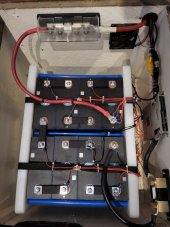Finally got my 8no CATL 280Ah cells installed in my boat. The system is complete with JK BMS, Victron Smart shunt and Class T fuse. I used 1" cutting board as compression plate material and 6no stainless steel threaded rods.
Plastic hydraulic pipe covers the threaded rod. I fitted stainless steel eye bolts to the floor of the battery box and used webbing to attach to the eyebolts with small shackles. To tension the webbing with used 1.5mm dyneema kite lines as a lashing. This worked well.
We have 720w of solar on a 44ft monohull.
We have bean running the system for the last 10 days in the Caribbean. We have not used any propane to cook with apart from on the oven. We are using an electric kettle, induction hob, immersion heater for hot water and running the 220v watermaker with 1.9kw load all through the 3kw inverter. We haven't used the diesel generator at all. All power has come from 720w of solar plus a wind turbine.
Our daily harvest is just under 4kw with the wind turbine contributing a little bit more. We have kept our 4no Trojan t105RE batteries for now so we have a back up but we will ditch those in the future for a second smaller lithium bank of 8no 120Ah (or there abouts) cells and a seperate BMS
 .
.
Plastic hydraulic pipe covers the threaded rod. I fitted stainless steel eye bolts to the floor of the battery box and used webbing to attach to the eyebolts with small shackles. To tension the webbing with used 1.5mm dyneema kite lines as a lashing. This worked well.
We have 720w of solar on a 44ft monohull.
We have bean running the system for the last 10 days in the Caribbean. We have not used any propane to cook with apart from on the oven. We are using an electric kettle, induction hob, immersion heater for hot water and running the 220v watermaker with 1.9kw load all through the 3kw inverter. We haven't used the diesel generator at all. All power has come from 720w of solar plus a wind turbine.
Our daily harvest is just under 4kw with the wind turbine contributing a little bit more. We have kept our 4no Trojan t105RE batteries for now so we have a back up but we will ditch those in the future for a second smaller lithium bank of 8no 120Ah (or there abouts) cells and a seperate BMS
 .
.


